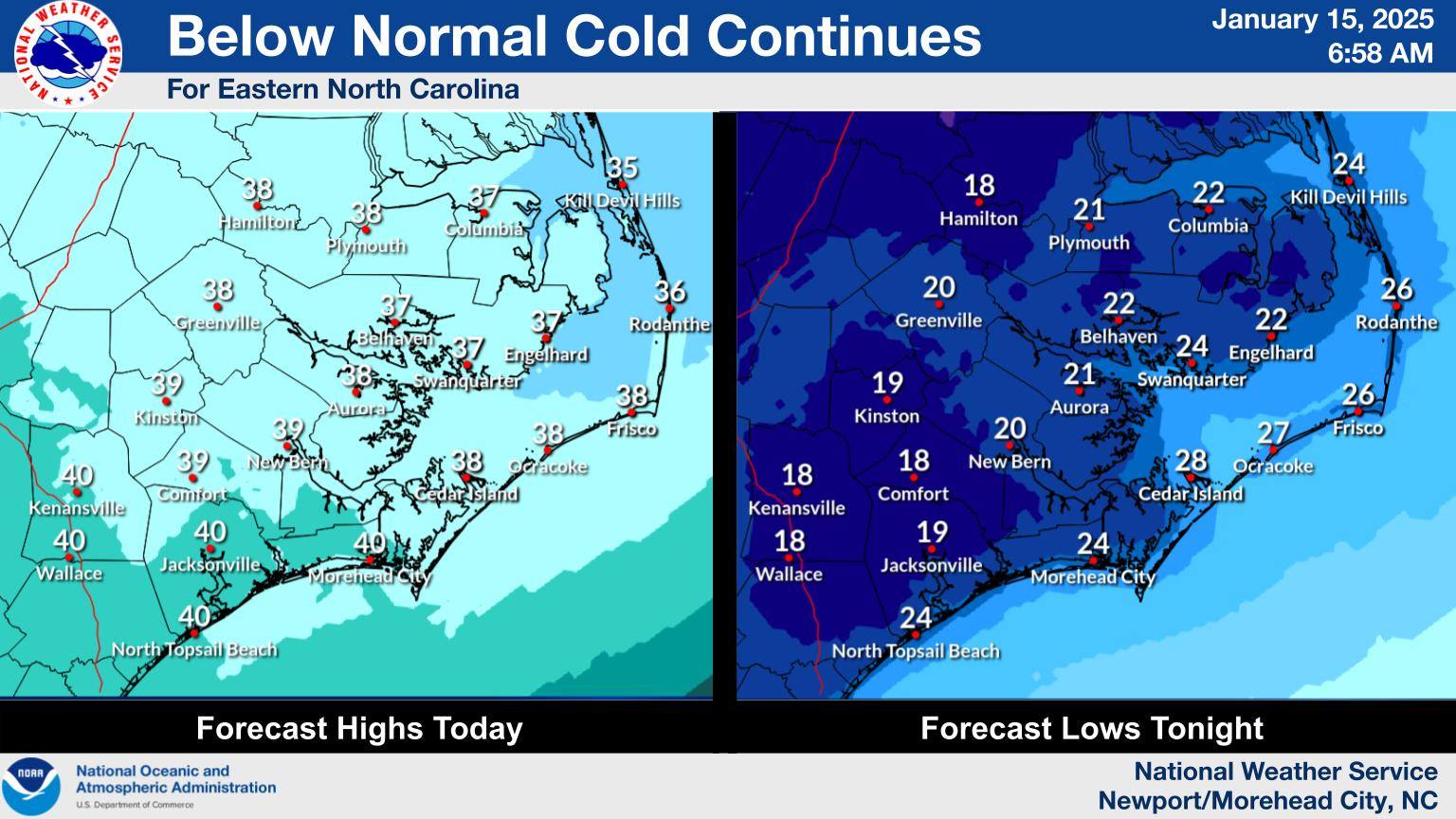FOR MORE INFORMATION
By JOY CRIST
At the Jan. 17 Board of Commissioners meeting, the final Classification and Compensation Study from outside contractor, Springsted, Inc., was presented to the commissioners by John Anzivino, senior vice president of the Richmond office.
The headline in the report is sure to get the attention of the county’s workforce.
Anzivino said the study effectively found that 38 percent of Dare County employees fell below the recommended minimum pay grade.
“The census in a large organization like Dare County is constantly shifting, because people are retiring, people are moving on to other positions, people are being hired,” he said. “But of the 738 employees that we had in our last census, we found that 280 of those employees were below the recommended minimums of the salary grades that we had developed.”
Anzivino began by telling the board members, “I’m here to talk about your most valuable resource here in the county: the employees that provide services to your citizens as well as the many visitors, including myself, who come to Dare County to spend their time.”
The study was commissioned in June of 2016 and examines the pay structure for county employees, and determines if any adjustments need to be made to the current pay grades.
“We have looked at approximately 736 employees, what they do, whether they are paid competitively in the labor market, and what some of the impacts might be,” said Anzivino.
Board members received a copy of the report over the weekend and were given a copy of the analysis of board compensation at the BOC meeting. In that hand-out, it was noted that Dare County commissioners received $8,801 annual compensation plus $3,600 for travel while the county chairman received $9,256 annually plus $4,900 for travel.
The purpose of the study was to respond to changing market conditions and support the county’s efforts to attract and retain quality employees. In addition, the study examined changes in employees’ duties and responsibilities due to workplace and organizational changes, as well as job descriptions that may have changed. The study also looked at internal equity and consistency among similar positions, as well as whether salaries were competitive to other appropriate labor markets.
Studies like this one are conducted by local governments to ensure that compensation and benefits are competitive in the labor market, the job descriptions are accurate, and that salary compression issues are addressed and Federal regulations are met, among other factors – like employee turnover, which can be a costly event in more ways than one.
“When you do have a high rate of turnover, it does create a drag on service to the citizens in the community,” said Anzivino.
Typical cycles for classification and compensation occur on the local government level every five to seven years . Nationally, Anzivino noted, the years 2003-2008 were overall a “hot labor market” period, while 2009-2012 was much slower, and the years from 2012 to present saw a more invigorated market in which employee compensation tended to rise.
Anzivino also noted that the compensation philosophy they worked towards during the study included providing fair and equitable compensation in an increasingly competitive and changing labor market, and maintaining a competitive pay structure that takes into consideration Dare County’s resources, as well as individual performance that meets or exceeds expectation.
Springsted was tasked with a number of objectives throughout the study. Meetings with the county manager and department directors, county employee orientation meetings, and an overall collection of data were all listed as key components of the study. From there, Springsted was assigned the development of preliminary classifications, an evaluation of positions, the development of salary line, and an assignment of positions to pay grades.
“…This type of work is about 70 percent science and 30 percent art, because we analyze a lot of information, and gather a lot of data,” said Anzivino. “…One job may not be exactly identical to another job that may appear to be in the same rate assignment, so you have to consider those things.”
The study involved meetings with Dare County supervisors and employees in the process, and the Springsted personnel had 24 meetings with the employees that were roughly one hour long each during the process.
“At those meetings, we wanted to temper expectations that everyone was going to get a big salary increase.” said Anzivino “…We want to temper that, because at that point in time, we just don’t know… we don’t have that knowledge [yet] at that time.”
Referring to the fact that 38 of Dare County employees fell below the recommended minimum paygrade, Anzivino said, “One of our findings is that the county salary levels overall for your minimum, your mid-point, your maximums – your employees are being paid less than comparable regional organizations.”
Internal pay relationship inequities exist within Dare County, the study found, and in addition, the county’s pay plan has not been maintained as demonstrated by the survey data obtained and analyzed. As a result, this indicates that the county falls 7.13 percent below the recommended minimum average salaries, 6.02 percent below the midpoint average salaries, and 5.44 percent below the maximum average salaries of other localities approved by the county and responding to the survey.
Based on this data, Springsted developed a new salary schedule based on comparable markets — which includes 15 different communities that responded to a survey.
Any new salary schedules must be voted on and adopted by the Board of Commissioners to go into effect.
The proposed pay scale was utilizing the respondents’ survey data and is consistent with the other jurisdictions and contains 43 pay grades with a 5 percent separation between grades and a minimum to maximum spread of 60 percent. This is slightly greater than the current spread of 58 percent, which gives slightly more flexibility to the county for folks who are moving towards the maximum of their pay range.
Below is a detailed graph of the pay scale that is recommended by the study.
This is where the science behind the specifics — the positions that were assigned to the specific pay grades — gets a little complicated. The pay grades are based on the SAFE system, or the “Systematic Analysis and Factor Evaluation,” which is utilized for job evaluations for every position from manual labor positions to executive positions. The SAFE system determines pay grade based on a total of nine factors, such as training and ability, level of work, physical demands, experience required, working conditions, and other job or employee-specific details.
Based on this data, Anzivino recommended four options for moving forward from the study results to actual implantation.
OPTION 1: Move to Minimum of the Recommended Pay Grade
This entails bringing 38 percent of Dare County employees – or the aforementioned 280 who fall below the recommended minimum paygrade — up to “bare minimum” status. The annual salary cost of this option, which does not include benefit impacts, is $857,469 — equivalent to 2.82 percent of the county’s $30.4 million annual payroll. Anzivino noted during the presentation that this affects only employees that are currently below the recommended minimum.
OPTION 2 – Move to Minimum or 2 percent Increase — Whichever is Greater
In this scenario, 99 of employees are impacted. This option moves employees to the minimum paygrade, and / or would provide employees with a 2 percent increase – whichever is greater. According to the example that Anzivino noted during the presentation, an employee well under the minimum that requires 4 percent to get to the minimum status would receive a 4 percent pay increase. Whereas, an employee who was 1 percent below the minimum would receive a 2 percent increase to move them “a little further into the range.” The annual salary cost of this option is $1,258,402, which is equivalent to 4.14 percent of the county’s $30.4 million annual payroll.
OPTION 3 – Move to Minimum plus .05 percent per Year of Service
This option addresses the issue of salary compression, gets all employees to the minimum salary upgrade, and affects 99 percent of county employees. This scenario provides a .05 percent increase per year of service, so, as an example, if employees falls within the pay grade, and have 6 years of service under their belt, they receive a 3 percent increase. This option’s annual salary cost is $1,792,918, which is equivalent to 5.90 percent of the county’s $30.4 million annual payroll. According to Anzivino, this option better places personnel within the paygrade to which they are assigned – either close to the location where they should be, or better than they would be in the 2 percent or Option 2 Scenario.
Option 4 – Years of Service Adjustment
This option provides a 3 percent per year increase of service up to the mid-point. When the salary reaches the mid-point, it becomes market driven, and drops to a 2 percent increase.
“This really gets to the heart of your compression issues,” said Anzivino. “And when you deal with salary compression, it’s always an expensive challenge for the locality, because it’s providing more funds to move employees and place them properly in the range where they should have been if the system had been properly maintained, and there [hadn’t] been any economic downturn.”
This option has an annual cost of cost is $3,676,052, which is equivalent to 12.09 percent of the county’s $30.4 million annual payroll. Anzivino noted that this had a big impact on costs, so a two-year implementation was recommended to minimize effects.
Overall, the study recommended that the BOC approved the recommended salary schematics, and approve Option 4, recognizing that a phasing of the implementation option will be required.
Adoption of this recommendation will establish more equitable compensation levels for all employees, address compressions issues, and bring those employees that are below the market up to market standards,” said Anzivino.
In addition, in the vein of an ongoing administration program, the study orchestrators would work with county human resources in establishing policies for the BOC’s consideration. These policies would be established so that the BOC could create guidelines that best suit Dare County for future adjustments, such as adjustments that recognize individual employee performance.
FRINGE BENEFITS
Dare County is relatively comparative in the realm of “fringe benefits,” according to the study, which includes health benefits and paid days off.
The holiday leave is consistent with the survey average of 12 days. Pension and retirement, and life insurance, are both consistent with survey results, and perhaps slightly better. “You’re paying 100 percent for life insurance, and the average for other entities is 79 percent, so that’s an added benefit for your employees,” said Anzivino
“Your health insurance, though, is one where I think you do a good job,” noted Anzivino. According to the survey results, Dare County pays, on average, a higher premium amount for all levels of coverage and is above the survey averages for contributions at all levels.
The conclusion portion of the presentation also noted that if Dare County adopted the report’s recommendations, it would result in the following:
“Thank you very much for this detailed summary, and certainly it’s a lot to digest this evening, and we’ll be talking about this at our board retreat,” said Commissioner Chair Bob Woodard after the presentation.
Several commissioners also had questions regarding the science and data gathering behind the numbers, as well as what the salary increases represented.
Woodard noted that the numbers did not include FICA, and confirmed with county manager Bobby Outten that there would be roughly an additional half million dollars involved for option 4. “For the 3.6 percent option, you’re looking at something like 25 percent of that to go towards the contribution to retirement,” said Outten.
“I don’t have a calculator… but that number is jumping from 3.6% to 4.6%,” said Woodard.
Commissioner Shea asked if the study examined compensation packages.
“In your recommendation, I understand this is a salary study, but did you look at the total compensation packages?” he asked.
“Only in the form of how competitive your benefits programs were,” said Anzivino. “We did not add up the total value of the benefits tied into your total levels of compensation.”
“In my opinion that’s really the bottom line. The total compensation [package},” said Shea.
The presentation concluded with Woodard noting that the road ahead to determine the best course of action would be tricky, but would also be starting soon.
“[This is a] very comprehensive study,” said Woodard. “We’ve been adamant about making this happen for a long time, and we certainly have our work cut out for us to see how we can fund this, and we will be having these discussions at our [Jan. 27] board retreat.”
FOR MORE INFORMATION
Click here to read the entire 44-page study.













